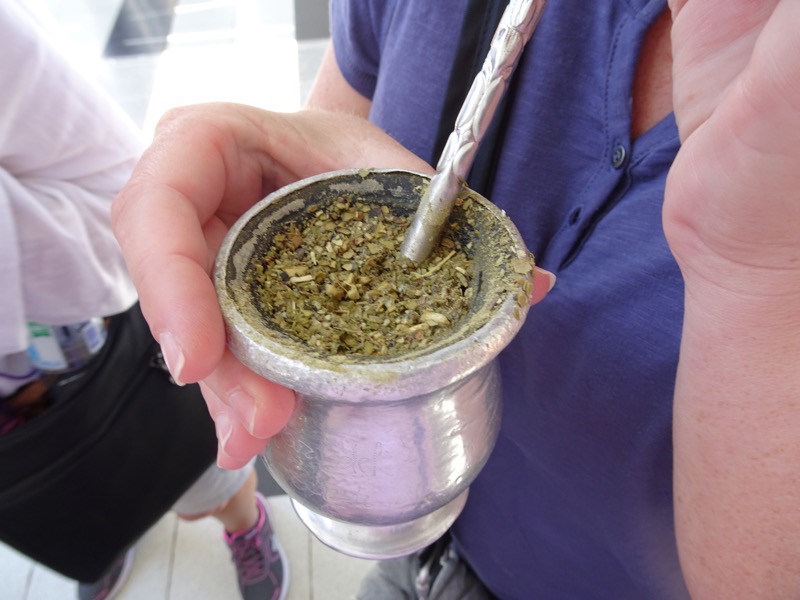We left Buenos Aires this morning – early. Too bloody early. Our flight wasn’t until 0920 and even though it was a domestic flight, we have been advised to get to the airport two hours beforehand – like you would for an international flight, on top of which it was going to take up to an hour to get to the airport… So our transfer was booked for 0630 with Jorge… Jorge was recommended to us by Ceri as a reliable driver with a vehicle large enough to take the four of us and our four largish suitcases. So yeah, we were up stupid early after being up drinking until 0130 or so. Clever, huh?
We made it to the airport in plenty of time – Jorge sped us safely through the early morning traffic while we watched the most startling pink sunrise come up over the shanty town areas of Buenos Aires. Again with the speed landscape photography, only the blurred mess I shot out the window of Jorge’s flying Mercedes minivan matched my foggy mental state perfectly on this occasion.

Have I ever mentioned how much I dislike ‘slum tourism’? By that I mean tours that take obviously financially comfortable/wealthy tourists into the favelas or shanty towns (which our tour yesterday did briefly) so they can gawk at how the people are living in poverty? I hate that shit. I can’t imagine how it would feel to be living in a run-down shack with a piece of corrugated tin for a roof and watch a $300,000+ bus roll through your neighbourhood with 50 or more wide-eyed, Sketcher wearing, fanny-pack wielding, (largely white) tourists staring at you from behind UV tinted windows. Fuck that. These people are living their lives and doing their best to get by – it’s not a spectacle, it’s survival.
But I’m off topic – we flew from Buenos Aires to Ushuaia with Aerolingus Argentina, a local airline who, unbeknownst to us had a 15kg luggage limit. Great, my bag with all its bulky warm stuff in it was nearly 20kg when we left home – the heaviest my suitcase has ever been when leaving the country (it’s routinely over 20kgs on the way home but never over about 16kgs when I leave). I got it down to 18.5kg but I still got slugged with a 590ARS (about $40) excess luggage fee anyway. (*Ed: I just met a woman named Shirley at dinner who flew with the same provider and her baggage was 6kgs over but her husband’s was right on 15kgs and she didn’t get charged. I was the only one of the four of us who was over, but I got charged. Bastards!). Any-hoo… in for a penny in for a pound, I say. So if I’m going to get slugged on the way home, I may as well go the full hog and head home with 25kgs – they’re just going to hit me with the fee anyway!
We also had a ‘hidden stopover’ on our flight – which meant we made a scheduled stop somewhere to refuel and to dump some passengers and pick up a few extras, only 95% of us just stayed in our seat during this roughly 45min process. I still have no idea where we were stopped, as most of the in-cabin announcements were in Spanish and English versions were so thickly accented I couldn’t understand them anyway. So a hidden stop-over and then onto Ushuaia.
Ed: I did find out from Jorge where this ‘hidden stop’ was – a place called, El Calafate in Patagonia which is famous for its Peiro Moreno Glacier which, just a week after we were there, had an enormous ice bridge calving…
Anyway, we arrived in Ushuaia and the first thing that happened was Aunty Mary left her backpack on the plane thinking one of us had grabbed it for her – which of course we didn’t as we had our hands full with overweight hand luggage that was supposedly keeping our checked bag weight down. So she had to go back to try on to the plane to try to find it – the staff had apparently moved it on her, but thankfully she managed to reclaim it. I was so relieved the missing backpack didn’t become a ‘thing’.


On the drive from the airport into town… I’m back in Ushuaia! Unbelievable.
We exited the airport (funky building it is too) where we were greeted by Quark Expedition staff, they helped us with our luggage and transferred us to our hotel… only it turned out they were transferring us to our hotels – plural.
For some reason, Aunty Mary and Lyn were staying at a different hotel, we had no idea why because neither of them had brought paper copies of their booking with them, and they were (initially) none too pleased. Then Aunty Mary went around the back of the van to get her suitcase and it just wasn’t there either – whereupon a small panic ensued before it turned out they had already offloaded her bag while she was trying to ascertain why she was at a different hotel… A misplaced backpack and now a misplaced suitcase = not fun. Did I mention that we were all really rather tired?! :/
The view at their hotel apparently ameliorated the inconvenience of being in a hotel somewhat out of town it seems… and we received this pic fron them shortly after they checked in.

Trish and I were ferried to a different hotel, the Canal Beagle, right in downtown Ushuaia which was decidedly older and less flash and had a view much more like this – complete with construction, smashed windows, stray dogs and all good things.

Didn’t matter we were only going to be there for one night.
At 1830 we had a Quark Expeditions briefing where we found out that we wouldn’t actually be embarking until 1600 the following day. So this pick up day in Ushuaia was officially Day 1 of our trip, and we thought we were embarking first thing the following morning, but not so – we just had to have all our luggage at reception by 1000 so it could be transferred to the ship but we wouldn’t actually be embarking until 1600.
Which meant we had zero plans for an unexpected day in Ushuaia. Lyn and Aunty Mary decided they would book a helicopter tour over the area, and Trish and I decided to go to the Tierra del Fuego National Park – I went there on my last trip and it was positively spectacular, so I was happy to journey into the park again. I figured I would decide in the morning if I wanted to do the prisoner train again, but at least we roughly had a plan.
Next things next. Dinner. I found us a choice of two restaurants after a bit of Googling – the Restaurant Villaggio for seafood and Italian style dishes, or the Estancia Parilla for Argentinian BBQ. Well, we thought nothing was going to top our Desnivel steaks from the night before so we opted to go to Villaggio. Chosen for the enormous king crab options on the menu – not disappointed!


It was a lovely restaurant with delicious foods – we had a beautiful meal and then headed back to our hotel/s. King Crab Casserole with Roquefort cheese, Grilled Atlantic Salmon and fries, Tenderloin Steak (fillet) with Potatoes au Gratin and that whole crab platter photo was snapped at a nearby table.
After dinner, we went for a quick wander through town back towards our hotel, but of course, most places were closed for the evening so we will have to double back and explore more tomorrow.

 Gifts made from Rhodocrosite also known as Rosa del Inca or Inca Rose stone. It is the national stone of Argentina and is particualrly stunning for it’s beautfiul red and pink hues.
Gifts made from Rhodocrosite also known as Rosa del Inca or Inca Rose stone. It is the national stone of Argentina and is particualrly stunning for it’s beautfiul red and pink hues.

And thus endeth our uneventful transit day… all things being relative.




 Each home has its own little jetty or pontoon as this is a community that thrives on its waterways. They have mail boats, rubbish boats, supermarket boats and even ice-cream boats that service the community. Kids get to and from school by boat.
Each home has its own little jetty or pontoon as this is a community that thrives on its waterways. They have mail boats, rubbish boats, supermarket boats and even ice-cream boats that service the community. Kids get to and from school by boat.
 Houses are varying from grand to dilapidated, some have permanent residents and many are able to be rented as holiday destinations. The guide on the boat mentioned that many of them are weekend homes for people who live and work in the city.
Houses are varying from grand to dilapidated, some have permanent residents and many are able to be rented as holiday destinations. The guide on the boat mentioned that many of them are weekend homes for people who live and work in the city. In the centre of the delta is this odd house covered by a glass cube – it is the house of one, Domingo Faustino Sarmiento, considered the ‘Father of Argentinian Classrooms’ or the founder of modern Argentinian education. Built in the 1860s, the house has been placed in the glass cube to preserve it from the wind, weather and constant humidity.
In the centre of the delta is this odd house covered by a glass cube – it is the house of one, Domingo Faustino Sarmiento, considered the ‘Father of Argentinian Classrooms’ or the founder of modern Argentinian education. Built in the 1860s, the house has been placed in the glass cube to preserve it from the wind, weather and constant humidity. The area is well known for its rowers and the Argentinian Rowing Club is located in the delta… leading to the common site of crazy people out rowing at midday… without hats.
The area is well known for its rowers and the Argentinian Rowing Club is located in the delta… leading to the common site of crazy people out rowing at midday… without hats. Further towards the town of Tigre, you can see large marketplaces where people can come (by boat) to do larger shopping and pick up supplies.
Further towards the town of Tigre, you can see large marketplaces where people can come (by boat) to do larger shopping and pick up supplies. Also nearby is the famous Parque de la Costa, which is like the largest amusement park in Argentina or South America or something or other… I kinda wasn’t paying attention when he said that bit
Also nearby is the famous Parque de la Costa, which is like the largest amusement park in Argentina or South America or something or other… I kinda wasn’t paying attention when he said that bit  In my defence, we do live barely half an hour from a handful of theme parks, so I’m not all that interested in them.
In my defence, we do live barely half an hour from a handful of theme parks, so I’m not all that interested in them. After our genteel pottering around on boats for the morning, we got to go visit the beautiful Cathedral de San Isidro which, oddly enough, is located in the centre of the small town of San Isidro. The Cathedral was built in 1898 on the site where a cathedral had stood since the early 1700s. As per usual for South American structures from this period (well, so it seemed from our extensive tour last year), it was designed by French architects and is built in a very aesthetically pleasing, neogothic style.
After our genteel pottering around on boats for the morning, we got to go visit the beautiful Cathedral de San Isidro which, oddly enough, is located in the centre of the small town of San Isidro. The Cathedral was built in 1898 on the site where a cathedral had stood since the early 1700s. As per usual for South American structures from this period (well, so it seemed from our extensive tour last year), it was designed by French architects and is built in a very aesthetically pleasing, neogothic style.  It has gorgeous stained glass windows and its spire reaches just shy of 70m tall (which is the same height as Buenos Aire’s Obelisk, don’t you know?). It has recently undergone extensive renovations which is why the entire building looks brand new. It is a truly lovely church.
It has gorgeous stained glass windows and its spire reaches just shy of 70m tall (which is the same height as Buenos Aire’s Obelisk, don’t you know?). It has recently undergone extensive renovations which is why the entire building looks brand new. It is a truly lovely church.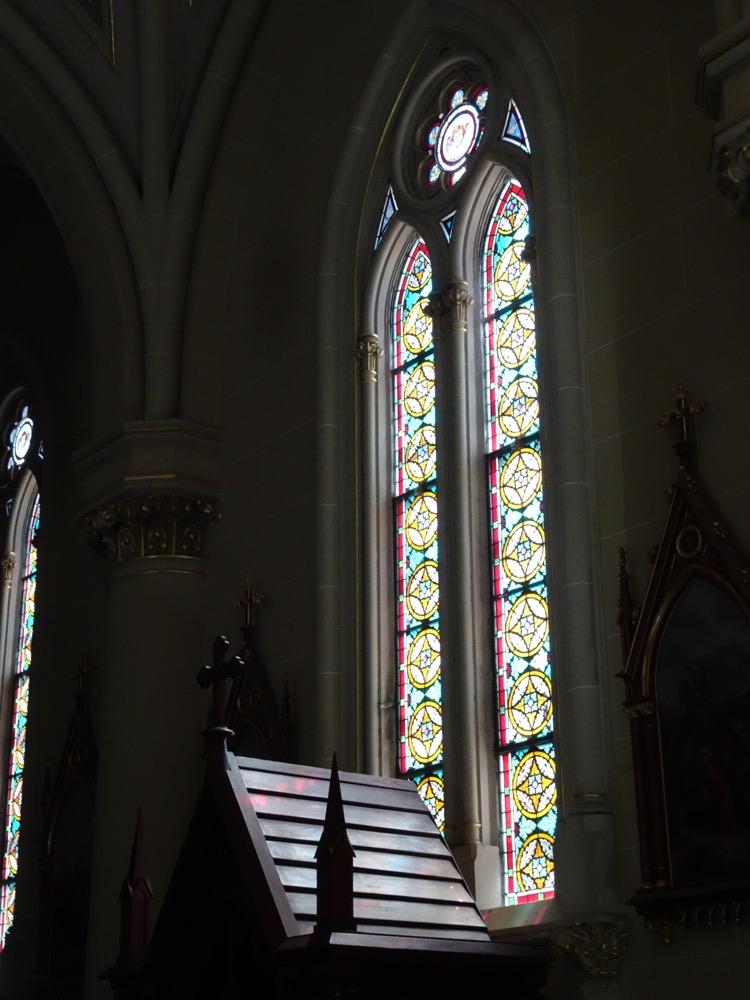 After we visited the Cathedral we had a quick stop, just long enough for a lemon gelato and then it was time to head back to Buenos Aires. We decided to make like the Spanish for the remainder of the afternoon and have a much-needed siesta.
After we visited the Cathedral we had a quick stop, just long enough for a lemon gelato and then it was time to head back to Buenos Aires. We decided to make like the Spanish for the remainder of the afternoon and have a much-needed siesta.

 Anyway, we made it to Desnivel just as the place was opening at 7pm. Argentines traditionally dine quite late and while we wandered into a nearly empty restuarant, the place was getting quite busy as patrons kept walking in as late as 9:30pm to 10pm.
Anyway, we made it to Desnivel just as the place was opening at 7pm. Argentines traditionally dine quite late and while we wandered into a nearly empty restuarant, the place was getting quite busy as patrons kept walking in as late as 9:30pm to 10pm.

 After we ordered some drinks – caipirinha, margartita, and pisco sours… our lump of wax came out like this – well cooked and covered in peppers, bacon, provoletta, and herbs. Absolutely beautiful. Add a tiny bit of chimichurri and Bob’s your uncle.
After we ordered some drinks – caipirinha, margartita, and pisco sours… our lump of wax came out like this – well cooked and covered in peppers, bacon, provoletta, and herbs. Absolutely beautiful. Add a tiny bit of chimichurri and Bob’s your uncle. After sharing some provaletta for an entre, we had steak tenderloins (what we would just call a fillet steak) that was served drowning in delicious mushroom sauce and with pomme noisettes. None a pesky vegetable in sight at this steakhouse
After sharing some provaletta for an entre, we had steak tenderloins (what we would just call a fillet steak) that was served drowning in delicious mushroom sauce and with pomme noisettes. None a pesky vegetable in sight at this steakhouse  And Ceri was right, I have never – and I mean that literally – I have never had such tender steak in my life. Thanks to Ceri’s advice we ordered one steak between the two of us and didn’t have to be rolled out of the restaurant.
And Ceri was right, I have never – and I mean that literally – I have never had such tender steak in my life. Thanks to Ceri’s advice we ordered one steak between the two of us and didn’t have to be rolled out of the restaurant. The steak cut like butter and almost melted in your mouth. It was beautifully cooked and so light and tender. Phenomenal… we were all commenting what a shame it was we hadn’t made the effort to come last night as we would have been back for a second meal tonight as well, it was that good!
The steak cut like butter and almost melted in your mouth. It was beautifully cooked and so light and tender. Phenomenal… we were all commenting what a shame it was we hadn’t made the effort to come last night as we would have been back for a second meal tonight as well, it was that good! Eventually our waiter just brought over the damn bottle.
Eventually our waiter just brought over the damn bottle. 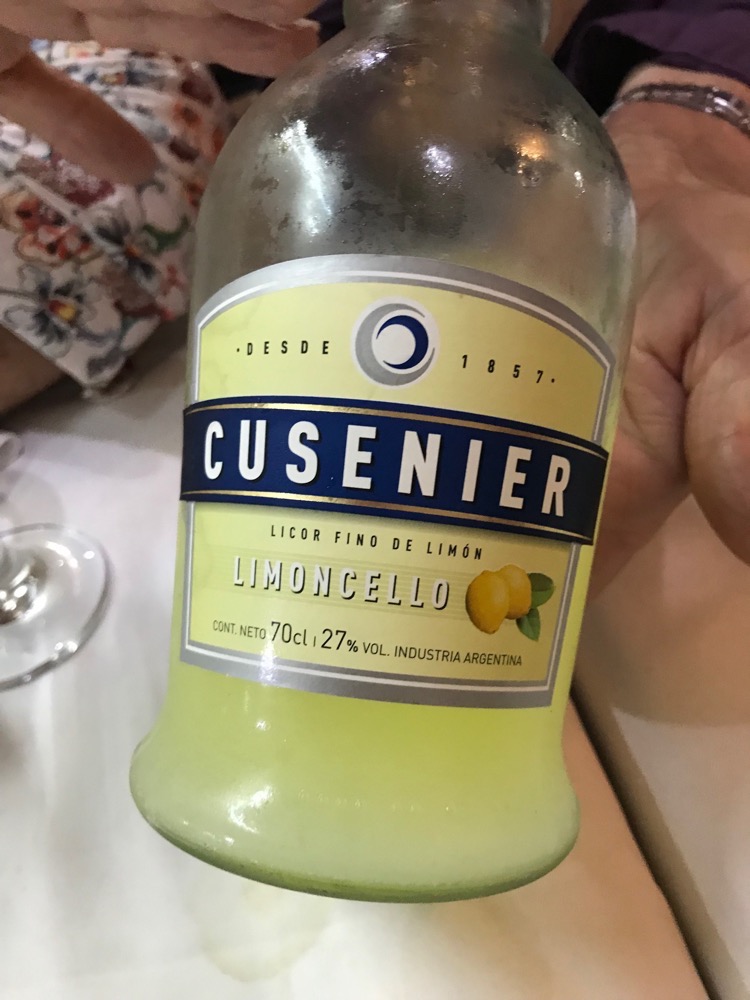 Finally, well fed and cheerful, we paid for our meal in what looks like a king’s ransom and spilled out onto the street to find a cab.
Finally, well fed and cheerful, we paid for our meal in what looks like a king’s ransom and spilled out onto the street to find a cab.
 One of our next stops was the Parque Lezama… where we roundly ignored the statue of Pedro de Mendoza who allegedly founded the city of Buenos Aires in 1536, and went instead wandering the back streets to find a cafe. Being Australian, Ceri thought we’d want to find ‘good coffee’. It is apparently the one thing that Australians want when they get here and so he took us to a cafe- where we ordered one lemonade, one iced tea and one iced coffee, as I don’t drink coffee at all and none of us are big coffee drinkers. It was at this point, he questioned if we were actually Australian.
One of our next stops was the Parque Lezama… where we roundly ignored the statue of Pedro de Mendoza who allegedly founded the city of Buenos Aires in 1536, and went instead wandering the back streets to find a cafe. Being Australian, Ceri thought we’d want to find ‘good coffee’. It is apparently the one thing that Australians want when they get here and so he took us to a cafe- where we ordered one lemonade, one iced tea and one iced coffee, as I don’t drink coffee at all and none of us are big coffee drinkers. It was at this point, he questioned if we were actually Australian.
 Random window above the street level near Defensor – makes me feel like the repair work I need to do on my own home isn’t so desperate after all.
Random window above the street level near Defensor – makes me feel like the repair work I need to do on my own home isn’t so desperate after all. The streets on the way to Casa Rosada – the famous Presidential Palace, were increasingly congested with all the protesting that was going on. The Casa Rosada was so busy and surrounded by so much construction, clumps of cruise ship tourists, traffic and chaos that I have stolen… err appropriated, a pic from Wikipedia to include here so you can actually see (and so that I will be able to remember) what the building it is supposed to look like!
The streets on the way to Casa Rosada – the famous Presidential Palace, were increasingly congested with all the protesting that was going on. The Casa Rosada was so busy and surrounded by so much construction, clumps of cruise ship tourists, traffic and chaos that I have stolen… err appropriated, a pic from Wikipedia to include here so you can actually see (and so that I will be able to remember) what the building it is supposed to look like! We sat on some steps opposite the Palace and had a discussion about the building, and rebuilding of the Palace over the years, the state of Argentinian politics, and discussed some of the different approaches that Argentina vs Australia take to global problems. For example on immigration – Argentina is seeing a lot of Venezuelan immigrants at the moment as a result of instability in that region and rather than take those refugees and ship them offshore to detention hellholes, the Argentinan government is expediting visas and citizenships for these people primarily because they bring skills and abilities to the country, but there’s an added benefit that it is apparently pissing off the Venezuelan government to no end.
We sat on some steps opposite the Palace and had a discussion about the building, and rebuilding of the Palace over the years, the state of Argentinian politics, and discussed some of the different approaches that Argentina vs Australia take to global problems. For example on immigration – Argentina is seeing a lot of Venezuelan immigrants at the moment as a result of instability in that region and rather than take those refugees and ship them offshore to detention hellholes, the Argentinan government is expediting visas and citizenships for these people primarily because they bring skills and abilities to the country, but there’s an added benefit that it is apparently pissing off the Venezuelan government to no end.
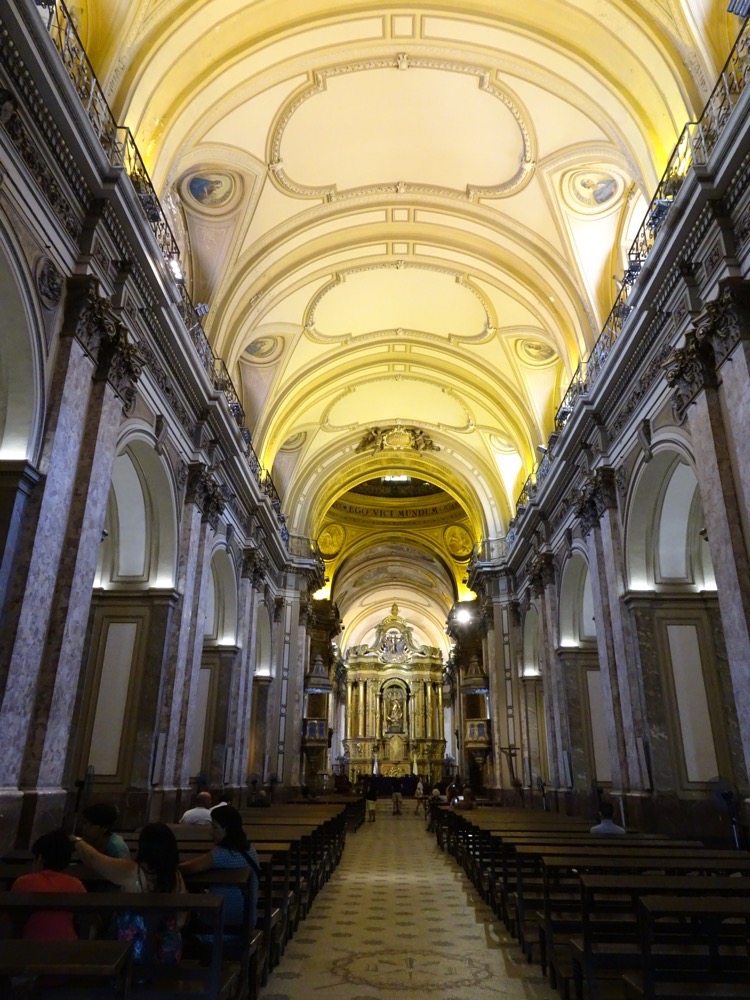


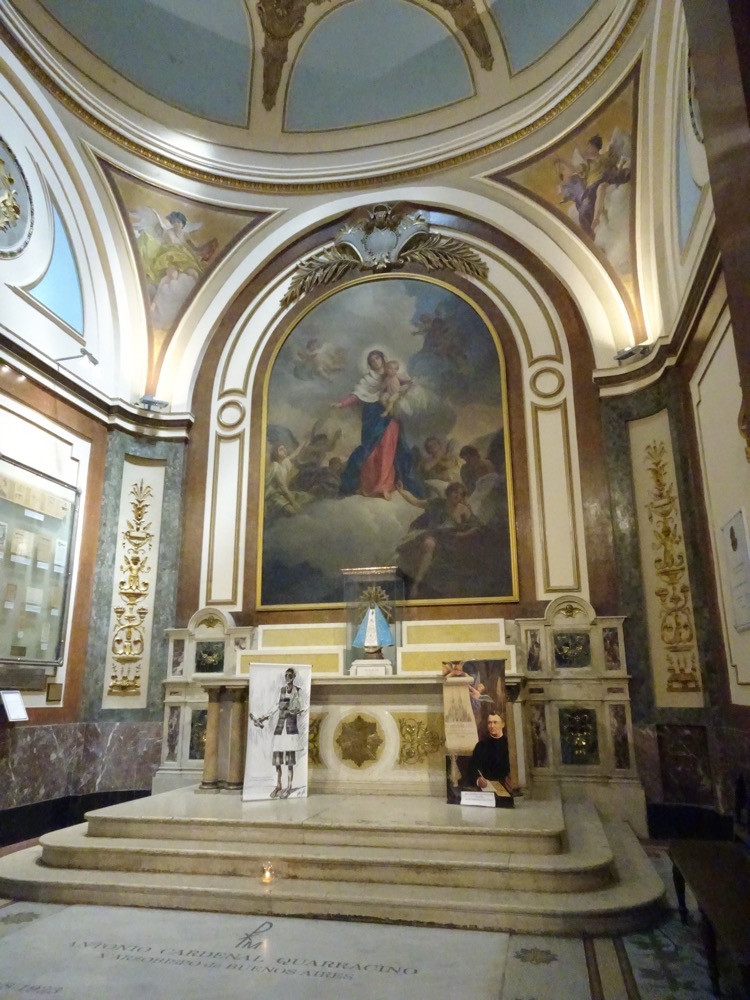 The Cathedral fronts directly onto the Plaza del Mayo which is a large open space often used for protesting… most notably it is the site where the ‘Mothers of the Plaza de Mayo’ congregate every Thursday as they have done since the mid-1980s. The Mothers of the Plaza de Mayo have been turning up protesting that they do not know what has happened to their children and the tens of thousands of people who were ‘disappeared’ between 1976 and 1983. At that time, anyone who protested against the dictatorial government would find themselves ‘disappeared’. Protesting was outlawed and protestors were kidnapped, tortured and murdered (apparently a favoured way to get rid of political dissidents was to torture them and then to fly them over the River Plata and throw them out of planes) This state-run terrorism campaign of the military dictatorship operated between 1976 and 1983, which is when the Mothers of the Plaza de Mayo organised and started to protest the disappearance of their children. You see the very Catholic Argentinians adore and respect their mothers above all else and they knew that no Argentinians would stand idle if they saw mothers being beaten and subdued in the streets. So the government just had to let them alone… and while protesting is now completely legal, the Mothers have refused to be silent and they continue to protest nearly 40 years on.
The Cathedral fronts directly onto the Plaza del Mayo which is a large open space often used for protesting… most notably it is the site where the ‘Mothers of the Plaza de Mayo’ congregate every Thursday as they have done since the mid-1980s. The Mothers of the Plaza de Mayo have been turning up protesting that they do not know what has happened to their children and the tens of thousands of people who were ‘disappeared’ between 1976 and 1983. At that time, anyone who protested against the dictatorial government would find themselves ‘disappeared’. Protesting was outlawed and protestors were kidnapped, tortured and murdered (apparently a favoured way to get rid of political dissidents was to torture them and then to fly them over the River Plata and throw them out of planes) This state-run terrorism campaign of the military dictatorship operated between 1976 and 1983, which is when the Mothers of the Plaza de Mayo organised and started to protest the disappearance of their children. You see the very Catholic Argentinians adore and respect their mothers above all else and they knew that no Argentinians would stand idle if they saw mothers being beaten and subdued in the streets. So the government just had to let them alone… and while protesting is now completely legal, the Mothers have refused to be silent and they continue to protest nearly 40 years on.
 We stepped out of the cafe and ran smack bang into… wouldn’t you know it, a workers union protest. It was at this point I asked Ceri if all this political engagement and protesting ever brought about tangible change to which he replied, ‘Not really, but now they have their right to protest back, they’re intent on using it.’
We stepped out of the cafe and ran smack bang into… wouldn’t you know it, a workers union protest. It was at this point I asked Ceri if all this political engagement and protesting ever brought about tangible change to which he replied, ‘Not really, but now they have their right to protest back, they’re intent on using it.’ From here we made our way to 9 July Avenue where one of the famous Evita balconies is located as well as an enormous 70m obelisk. The Obelisco de Buenos Aires was erected in the Plaza de la República on 9 de Julio in 1936 to commemorate the quadricentennial of the foundation of the city. It’s quite a striking monument – you can’t miss it!
From here we made our way to 9 July Avenue where one of the famous Evita balconies is located as well as an enormous 70m obelisk. The Obelisco de Buenos Aires was erected in the Plaza de la República on 9 de Julio in 1936 to commemorate the quadricentennial of the foundation of the city. It’s quite a striking monument – you can’t miss it!

 The large walled cemetery is similar to one we saw in Punta Arenas in Chile last year, but quite five times the size, and quite ten times as ostentatious in its display of wealth and status. The mausoleums are enormous, and all the materials and workmanship would have been imported from Europe.
The large walled cemetery is similar to one we saw in Punta Arenas in Chile last year, but quite five times the size, and quite ten times as ostentatious in its display of wealth and status. The mausoleums are enormous, and all the materials and workmanship would have been imported from Europe.

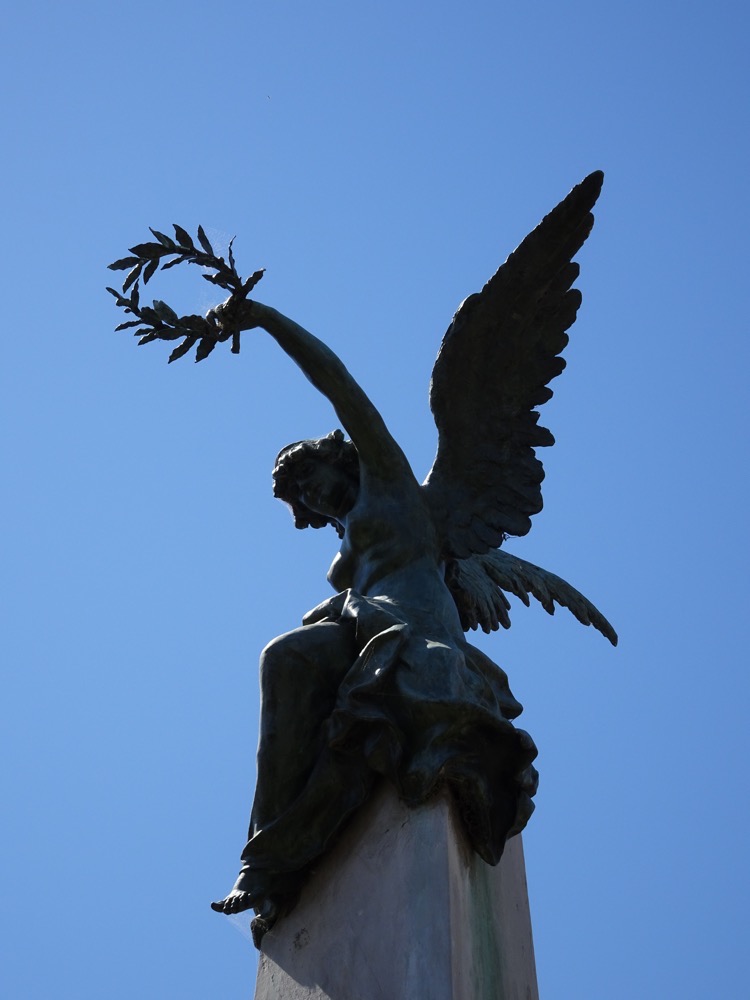

 People from many different denominations are buried here. The Argentinians are a very cosmopolitan people having come from everywhere – this appears to have been the result of a dreadful policy that encouraged the slaughter of the indigenous peoples in the past, but has created a society that knows they are all from somewhere else, so they appear to be more tolerant of one another… Ceri claims the Argentines ‘are mostly Italian and Irish descent, speaking Spanish, dressing like French and wanting to be British.’
People from many different denominations are buried here. The Argentinians are a very cosmopolitan people having come from everywhere – this appears to have been the result of a dreadful policy that encouraged the slaughter of the indigenous peoples in the past, but has created a society that knows they are all from somewhere else, so they appear to be more tolerant of one another… Ceri claims the Argentines ‘are mostly Italian and Irish descent, speaking Spanish, dressing like French and wanting to be British.’
 Presidente Alfonsin’s grave site – unlike most of the tombs here, this one is open sided and not locked.
Presidente Alfonsin’s grave site – unlike most of the tombs here, this one is open sided and not locked.

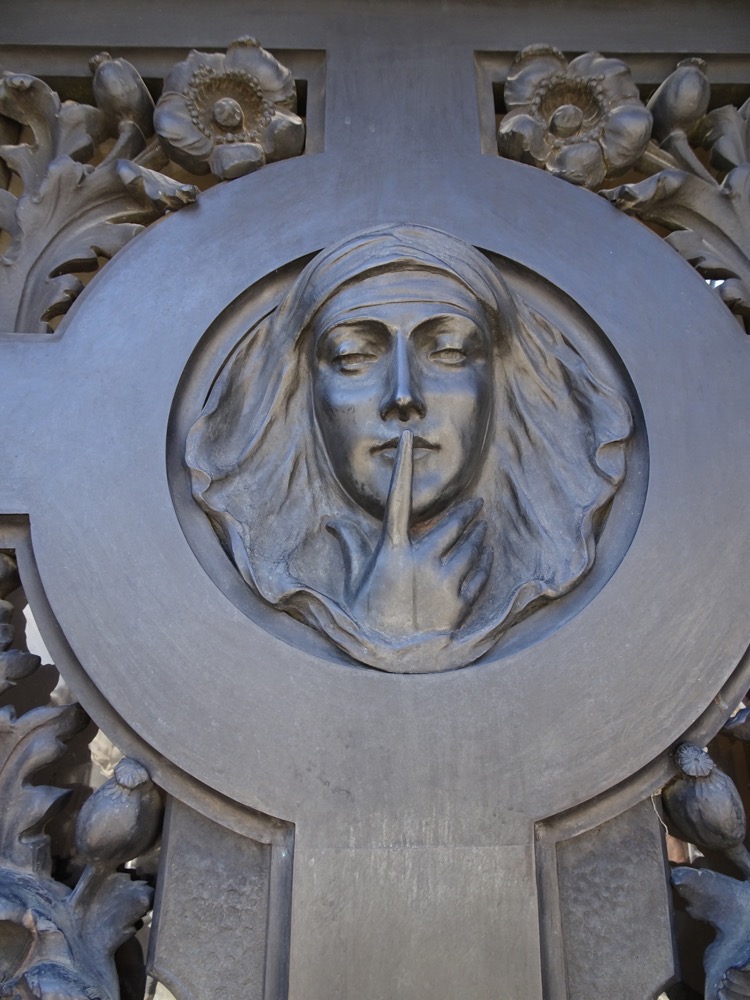
 The graves are rich with symbolism – from trees of life, owls of wisdom, anchors of hope and memento mori.
The graves are rich with symbolism – from trees of life, owls of wisdom, anchors of hope and memento mori.
 This is a couple who hated each other but who were forced to live out their lives together – Catholics do not divorce – so in death they chose to be buried in the family plot feet pointing towards each other and busts facing away, not side by side as most loving couples would. It’s very honest in its own way.
This is a couple who hated each other but who were forced to live out their lives together – Catholics do not divorce – so in death they chose to be buried in the family plot feet pointing towards each other and busts facing away, not side by side as most loving couples would. It’s very honest in its own way.





 This is a momument to a woman named Ida – a very personal homage from a grieving husband. Ida fell from a building and this statue depicts a woman helping her into the heavens.
This is a momument to a woman named Ida – a very personal homage from a grieving husband. Ida fell from a building and this statue depicts a woman helping her into the heavens.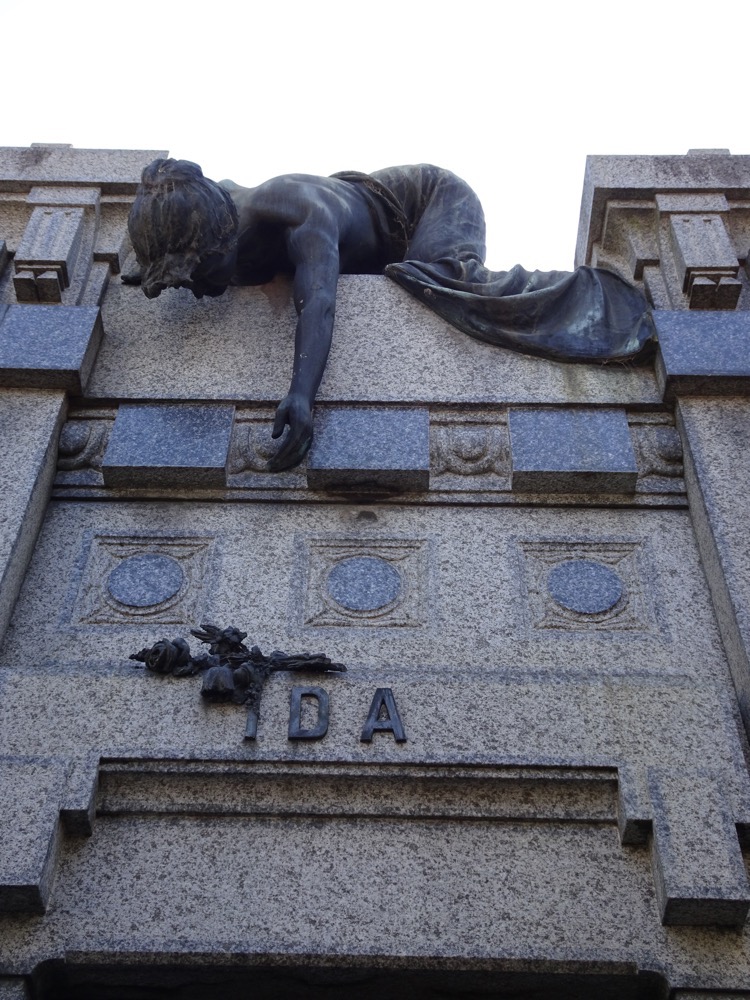 Eva Peron’s grave – the most visited grave in the cemetery. It is the only one covered in flowers and tokens, though compared to many of the other tombs, it is plain, simple and not particularly artistic. Evita was a very divisive figure so it is the only place in the cemetery that is under CCTV surveillance.
Eva Peron’s grave – the most visited grave in the cemetery. It is the only one covered in flowers and tokens, though compared to many of the other tombs, it is plain, simple and not particularly artistic. Evita was a very divisive figure so it is the only place in the cemetery that is under CCTV surveillance.




